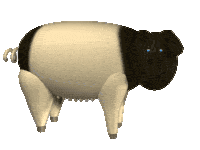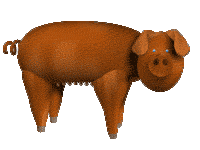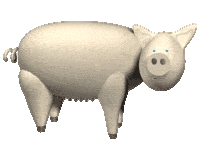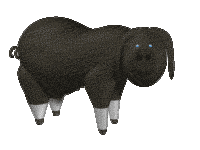|
|
The Funnypigs game rules (Level 1, Level 2, Level 3, Level 4, Level 5)
IN THE BEGINNING...
- FAQ & configuration requirements
- Funnypigs? What's that all about?
- How to become the proud owner of a pig - registration
- Where do I start?
ALL LEVELS
- Strikes
- Weather conditions and weather forecast
- The barn
- Bonuses, what is their use?
- Events, taxes and grants
- The market
- The Keko, Funnypigs' currency
- My account details
- How to get to the next level
- How to bring back to life a dead pig/sow/litter
- The Alley, the dealer and the attacks (weevils, crows, corn borers, rats, health and safety inspections, wild boars)
- Taxes: all you need to know
- The Town Caretaker - going on holidays without letting your pig die
- Farmer ranking system and points
- Monitoring your farmer friends
- The Café and the Forum
- Funnypigs' internal e-mail service: Funny-Mail
- Manure
- The wolf
- The top 10 farmers & the top 10 profits
- The warehouse
- The wild boar
- Funnypigs' manufacturing workshops
LEVEL 1
- How to care for your pig
- Funnypigs V2
- The field at Level 1
LEVEL 2
- How to care for your pig
- Funnypigs V2
- Machinery (Level 2, 3, 4 and 5)
- The fields at Level 2
- The farmers' cooperative
LEVEL 3
- General remarks on Level 3
- Farmers' assignments, selling pigs from your farm & getting to Level 4
- Silos
- Fortified food: weight and fat gain. Producing your own fortified food
-
Sows - different breeds and specific characteristics
36. Sows - different breeds and specific characteristics
 - Sows - different breeds and specific characteristics - Sows - different breeds and specific characteristics
When you reach Level 3, the first thing you have to do is buy an appropriate sow for your assignment.
When you buy it, it's actually still a gilt. You need to care for it (feed it, treat it, clean it) properly.
A gilt eats up to 3 times a day but you have to come back at different intervals to fill its trough as it needs
about 3 hours to empty it (but of course it depends on its appetite - it's up to the gilt really).
After 23 days, it becomes a proper sow, which means it will be in heat for the first time (that lasts for 2 days). This is the right time
to inseminate it with the semen of the breeding boar you selected to complete your assignment.
The maximum weight of a sow is 185kg. Once it's reached that weight, it stops putting on any more weight, but you still
have to feed it, treat it and clean it. You can sell your sow of course but not when it's in gestation (when it's pregnant).
Your sow is bought by the Funnypigs cooperative at the current rate, published in the Gazette.
The life cycle of a sow:
- starts by being a gilt for the first 23 days
- is in heat for the following 2 days
- is in gestation for 10 days if it was inseminated (otherwise this stage is skipped)
- rests for 3 days
- is in heat for 2 days
- etc.
Careful:
- An old sow (160 days old) can not farrow as many piglets as a young sow. There are 2 fewer piglets per litter.
- A 230-day-old sow can no longer be inseminated. You need to sell it and buy a new one.
The different breeds of sow:
Note that the fat level of the sow is not added up to that of the breeding boar.

The Basque Black and White comes from the Basque country hence its name. Its breeding performance is average
but the quality of its meat is excellent. Its fat level reaches 28% if the breeding boar is a Basque Black and White too.
It's ideal if you want to produce excellent-quality meat. Cost: 200 Kekos.

The Duroc comes from the United-States. Its breeding performance is low but the quality of its meat is very good.
Its fat level reaches 30% if the breeding boar is a Duroc too. It's ideal if you want to produce good-quality meat. Cost: 200 Kekos.

The Large White comes from Europe. Both its breeding performance and the quality of its meat are average.
Its fat level reaches 46% if the breeding boar is a Large White too. It's ideal if you want to produce fatty meat. Cost: 200 Kekos.

The Meishan comes from China. Its breeding performance is quite outstanding but the quality of its meat is average.
Its fat level reaches 35% if the breeding boar is a Meishan too. It's ideal if you want to produce a large quantity of average-quality meat. Cost: 200 Kekos.
Close
- Breeding boar semen - different breeds and specific characteristics
- Inseminating a sow and interbreeding
- Litters of piglets
- Filling troughs, cleaning and caring for litters
- The different types of slurry pits
- The fields at Level 3 and 4
- Machinery (Level 2, 3, 4 and 5)
- Vitamin boxes and vet boxes
- Funnypigs Electricity Board (FEB), wind turbines and batteries
- The farmers' cooperative
LEVEL 4
- General remarks on Level 4
- Assembly instructions
- Machines and parts. Breakdowns
- Producing carcasses, lard and blood sausage
- Buying pigs at the Official Market
- Selling half-carcasses, lard and blood sausage
- Funnypigs Electricity Board (FEB), wind turbines and batteries
- The farmers' cooperative
All the other Level 4 characteristics are identical to those at Level 3.
LEVEL 5
- General remarks on Level 5
- Boar breeders
- Growers
- Funnypigs Electricity Board (FEB), wind turbines and batteries
- The farmers' cooperative
MISCELLANEOUS
- The Funnypigs Gazette
- Excluding a farmer & deleting an account
- Why are there advertisements on Funnypigs?
- Funnypigs' Charter (terms and conditions)
Back
|
|
|
|
|